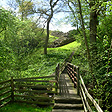HADRIAN’S
WALL
Hiking, Biking and Digging for 2,000 Years Roman History
 When
visiting towns of Northern England near the Scottish boarder one is
struck by
the stonework of the buildings.
Over the dark-ages in the 500 or so years after the fall of the Roman
Empire the inhabitants of this green land of rolling hills had a ready
source of stones. That long abandoned wall which snaked across the narrow
part of the British Isle from Bowness-on-Solway Bay in the west
to Newcastle-Upon Tyne on the eastern coast where the Tyne River flows
into the North Sea.
When
visiting towns of Northern England near the Scottish boarder one is
struck by
the stonework of the buildings.
Over the dark-ages in the 500 or so years after the fall of the Roman
Empire the inhabitants of this green land of rolling hills had a ready
source of stones. That long abandoned wall which snaked across the narrow
part of the British Isle from Bowness-on-Solway Bay in the west
to Newcastle-Upon Tyne on the eastern coast where the Tyne River flows
into the North Sea.
 Hadrian’s
Wall still remains today mostly as a low foundation across the landscape.
Dismantled rock
by rock in centuries past, it took
only six years to build by Roman Legions stationed at the northernmost
border of the Roman Empire. The wall was ordered to built by the Emperor
Hadrian in 122 AD and stretches 73 miles (80 Roman miles). Originally
15 feet high, the wall remants are now mostly 2 to 3 feet of stone
foundation
stretching
between the “Mile Forts”. Once built for defense, Hadrian’s
Wall is now made for touristing. There are a number of ways to experience
this unique historic landmark.
Hadrian’s
Wall still remains today mostly as a low foundation across the landscape.
Dismantled rock
by rock in centuries past, it took
only six years to build by Roman Legions stationed at the northernmost
border of the Roman Empire. The wall was ordered to built by the Emperor
Hadrian in 122 AD and stretches 73 miles (80 Roman miles). Originally
15 feet high, the wall remants are now mostly 2 to 3 feet of stone
foundation
stretching
between the “Mile Forts”. Once built for defense, Hadrian’s
Wall is now made for touristing. There are a number of ways to experience
this unique historic landmark.
 The Hadrian’s
Wall Path National Hiking Trail opened in 2003 and follows
the walls for 84 miles
of up
hill and down dale though beautiful green wild lands. Any visitor to
the wall will encounter hikers walking on the prepared footpath with
single ski hiking poles. Hiking gear can be found in the towns nearby.
Dress for changeable weather and carry a hiking
pack for the stops along the way. Located along the path are helpful
markers and sign posts of local services including
local
Bed & Breakfasts, restaurants, taxi services. Hadrian's Wall buses
stop at the main forts and museums along the wall from Carlisle to
Newcastle.
The Hadrian’s
Wall Path National Hiking Trail opened in 2003 and follows
the walls for 84 miles
of up
hill and down dale though beautiful green wild lands. Any visitor to
the wall will encounter hikers walking on the prepared footpath with
single ski hiking poles. Hiking gear can be found in the towns nearby.
Dress for changeable weather and carry a hiking
pack for the stops along the way. Located along the path are helpful
markers and sign posts of local services including
local
Bed & Breakfasts, restaurants, taxi services. Hadrian's Wall buses
stop at the main forts and museums along the wall from Carlisle to
Newcastle.
Hadrian’s Cycleway is part of the British National Cycling Network. The cycling path does not follow the wall closely for much of its distance, but the best place to see the wall by bicycle is the section between Banks Turret and Birdoswald Roman Fort. Hadrians Wall Heritage offers a number of “do-in-a-day” cycle maps providing routes to explore the landscape at a leisurely pace, visit quaint market towns, modern attractions and larger cities, along with rugged off-road trail for the more adventurous. The cycleway will eventually begin in Ravenglass and follow the north western coast of Cumbria, though section of this route are yet to be completed (See Muncaster Castle).
 Touring
Hadrian’s Wall
by car takes you along narrow country roads a few miles from the A69
motorway
between Carlisle and Newcastle, making
it possible to visit one or many parts of the wall on a tour of Northern
England. There are a number of museums and sights along the wall, several
of them are British Heritage Sites and some are privately operated museums.
A Great
British Heritage Pass
Touring
Hadrian’s Wall
by car takes you along narrow country roads a few miles from the A69
motorway
between Carlisle and Newcastle, making
it possible to visit one or many parts of the wall on a tour of Northern
England. There are a number of museums and sights along the wall, several
of them are British Heritage Sites and some are privately operated museums.
A Great
British Heritage Pass will
allow entrance into heritage sites, while the other museums require seperate
admission, though well worth it.
The section of Hadrian’s Wall between Brampton and Hexham is perhaps
the most picturesque.
 Birdoswald
Roman Fort just outside the town of Brampton comprises the
walls of a Roman Fort with a turrent and Mile Castles along with a
later
mansion built by an English nobleman who decided a Roman ruin was the
perfect view out his bedroom window, now looking out on groups of school
kids on field trips. The east gateway of the fort is one of the best
preserved. There are a number of walking trails around the fort and surrounding
area.
Birdoswald
Roman Fort just outside the town of Brampton comprises the
walls of a Roman Fort with a turrent and Mile Castles along with a
later
mansion built by an English nobleman who decided a Roman ruin was the
perfect view out his bedroom window, now looking out on groups of school
kids on field trips. The east gateway of the fort is one of the best
preserved. There are a number of walking trails around the fort and surrounding
area.
 Follow
the wall east about a mile to the Roman Army Museum,
a private facility with excellent exhibits
of army life in Roman times along the
wall, with artifacts found in excavations at the other unique site operated
by the same organization, Vindolanda Charitable Trust. At Vindolanda,
one of the largest sites along the wall a few miles farther east, you
can watch the active ongoing excavations
of the Roman garrison town with the foundations of buildings, walls and
towers laid bare. A
reconstructed tower shows how the wall and fortifications originally
appeared in life size. Stroll to the museum and walk through a Roman
statue
Follow
the wall east about a mile to the Roman Army Museum,
a private facility with excellent exhibits
of army life in Roman times along the
wall, with artifacts found in excavations at the other unique site operated
by the same organization, Vindolanda Charitable Trust. At Vindolanda,
one of the largest sites along the wall a few miles farther east, you
can watch the active ongoing excavations
of the Roman garrison town with the foundations of buildings, walls and
towers laid bare. A
reconstructed tower shows how the wall and fortifications originally
appeared in life size. Stroll to the museum and walk through a Roman
statue  garden
with replica Roman Temple. Inside the museum among other artifacts is
the most important antiquity archeological find in Great
Britain, the Vindolandia Tablets which have allowed an actual account
of life in a Roman Legion Garrison. There is of course a souvenir
shop and restaurant with outdoor seating in the gardens. Near
Vindolanda is Once Brewed, the former coaching inn carriage house pub
now the historic center
for tourist information visiting the Northumberland
National Park. Here you can get touring information about the wall and
the park. Next door is the Twice Brewed, an actually pub and restaurant
for the hungry and thirsty from following Roman Legion boot steps.
garden
with replica Roman Temple. Inside the museum among other artifacts is
the most important antiquity archeological find in Great
Britain, the Vindolandia Tablets which have allowed an actual account
of life in a Roman Legion Garrison. There is of course a souvenir
shop and restaurant with outdoor seating in the gardens. Near
Vindolanda is Once Brewed, the former coaching inn carriage house pub
now the historic center
for tourist information visiting the Northumberland
National Park. Here you can get touring information about the wall and
the park. Next door is the Twice Brewed, an actually pub and restaurant
for the hungry and thirsty from following Roman Legion boot steps.
 Homesteads
Roman Fort and Museum and Chesters Roman Fort and Corbridge
Roman Town are English Heritage sites between Bardon Mill
and Corbridge. In May and August on the bank holidays Birdoswald
Fort and Corbridge
have festivals with reenactors portraying Roman Legions in action.
Homesteads Fort has childrens activities in April and Chesters Roman
Fort offers
Roman Crafts activities in July and August. It is also
possible to follow the wall by rail. A number of the towns along Hadrian’s
Wall have rail stations, Carlisle, Haltwhistle, Bardon Mill, Hexham
(see Hexham Abbey),
Corbridge, Heddon-on-the-Wall
and Newcastle. The rail stations in main town centers are usually about
4-5 miles distant from the wall. © Bargain
Travel Europe
Homesteads
Roman Fort and Museum and Chesters Roman Fort and Corbridge
Roman Town are English Heritage sites between Bardon Mill
and Corbridge. In May and August on the bank holidays Birdoswald
Fort and Corbridge
have festivals with reenactors portraying Roman Legions in action.
Homesteads Fort has childrens activities in April and Chesters Roman
Fort offers
Roman Crafts activities in July and August. It is also
possible to follow the wall by rail. A number of the towns along Hadrian’s
Wall have rail stations, Carlisle, Haltwhistle, Bardon Mill, Hexham
(see Hexham Abbey),
Corbridge, Heddon-on-the-Wall
and Newcastle. The rail stations in main town centers are usually about
4-5 miles distant from the wall. © Bargain
Travel Europe
For a unique place to stay
near the wall LANGLEY
CASTLE
Reviews, tours and best deals at Hadrian's Wall
Web Info
Hadrian's
Wall Heritage
Vindolanda and Roman Army Museum
These articles are copyrighted and the sole property of Bargain Travel Europe and WLPV, LLC. and may not be copied or reprinted without permission.
See Also:
MANCHESTER MUSEUM SCIENCE AND INDUSTRY
DORCHESTER-ON-THAME
FAMILY ANCESTOR TRAVEL IN BRITAIN




